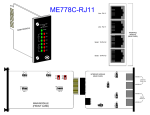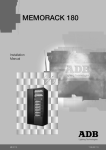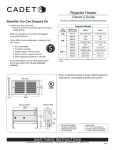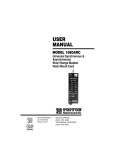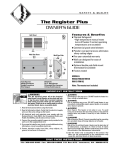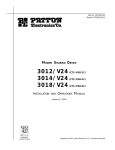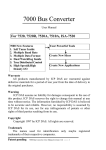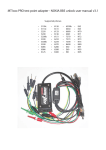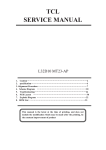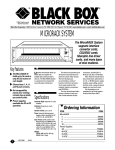Download Black Box ME758C-RJ11 User's Manual
Transcript
MAY 1995 ME758C-RJ11 ME758C-RJ45 ME759C-RJ11 ME759C-RJ45 Multi-Function LD Cards Power TD RD RTS CD Error Test Remote 511/E CUSTOMER SUPPORT INFORMATION Analog 511 Order toll-free in the U.S.: Call 877-877-BBOX (outside U.S. call 724-746-5500) FREE technical support 24 hours a day, 7 days a week: Call 724-746-5500 or fax 724-746-0746 Mailing address: Black Box Corporation, 1000 Park Drive, Lawrence, PA 15055-1018 Web site: www.blackbox.com • E-mail: [email protected] FCC STATEMENTS FEDERAL COMMUNICATIONS COMMISSION AND INDUSTRY CANADA RADIO FREQUENCY INTERFERENCE STATEMENTS This equipment generates, uses, and can radiate radio-frequency energy, and if not installed and used properly, that is, in strict accordance with the manufacturer’s instructions, may cause interference to radio communication. It has been tested and found to comply with the limits for a Class A computing device in accordance with the specifications in Subpart B of Part 15 of FCC rules, which are designed to provide reasonable protection against such interference when the equipment is operated in a commercial environment. Operation of this equipment in a residential area is likely to cause interference, in which case the user at his own expense will be required to take whatever measures may be necessary to correct the interference. Changes or modifications not expressly approved by the party responsible for compliance could void the user’s authority to operate the equipment. This digital apparatus does not exceed the Class A limits for radio noise emission from digital apparatus set out in the Radio Interference Regulation of Industry Canada. Le présent appareil numérique n’émet pas de bruits radioélectriques dépassant les limites applicables aux appareils numériques de la classe A prescrites dans le Règlement sur le brouillage radioélectrique publié par Industrie Canada. TRADEMARKS USED IN THIS MANUAL AT&T is a registered trademark of American Telephone and Telegraph Company. Littelfuse is a registered trademark of Littelfuse, Inc. Any other trademarks mentioned in this manual are acknowledged to be the property of the trademark owners. 1 MULTI-FUNCTION LD CARD NORMAS OFICIALES MEXICANAS (NOM) ELECTRICAL SAFETY STATEMENT INSTRUCCIONES DE SEGURIDAD 1. Todas las instrucciones de seguridad y operación deberán ser leídas antes de que el aparato eléctrico sea operado. 2. Las instrucciones de seguridad y operación deberán ser guardadas para referencia futura. 3. Todas las advertencias en el aparato eléctrico y en sus instrucciones de operación deben ser respetadas. 4. Todas las instrucciones de operación y uso deben ser seguidas. 5. El aparato eléctrico no deberá ser usado cerca del agua—por ejemplo, cerca de la tina de baño, lavabo, sótano mojado o cerca de una alberca, etc.. 6. El aparato eléctrico debe ser usado únicamente con carritos o pedestales que sean recomendados por el fabricante. 7. El aparato eléctrico debe ser montado a la pared o al techo sólo como sea recomendado por el fabricante. 8. Servicio—El usuario no debe intentar dar servicio al equipo eléctrico más allá a lo descrito en las instrucciones de operación. Todo otro servicio deberá ser referido a personal de servicio calificado. 9. El aparato eléctrico debe ser situado de tal manera que su posición no interfiera su uso. La colocación del aparato eléctrico sobre una cama, sofá, alfombra o superficie similar puede bloquea la ventilación, no se debe colocar en libreros o gabinetes que impidan el flujo de aire por los orificios de ventilación. 10. El equipo eléctrico deber ser situado fuera del alcance de fuentes de calor como radiadores, registros de calor, estufas u otros aparatos (incluyendo amplificadores) que producen calor. 11. El aparato eléctrico deberá ser connectado a una fuente de poder sólo del tipo descrito en el instructivo de operación, o como se indique en el aparato. 2 NOM STATEMENTS 12. Precaución debe ser tomada de tal manera que la tierra fisica y la polarización del equipo no sea eliminada. 13. Los cables de la fuente de poder deben ser guiados de tal manera que no sean pisados ni pellizcados por objetos colocados sobre o contra ellos, poniendo particular atención a los contactos y receptáculos donde salen del aparato. 14. El equipo eléctrico debe ser limpiado únicamente de acuerdo a las recomendaciones del fabricante. 15. En caso de existir, una antena externa deberá ser localizada lejos de las lineas de energia. 16. El cable de corriente deberá ser desconectado del cuando el equipo no sea usado por un largo periodo de tiempo. 17. Cuidado debe ser tomado de tal manera que objectos liquidos no sean derramados sobre la cubierta u orificios de ventilación. 18. Servicio por personal calificado deberá ser provisto cuando: A: El cable de poder o el contacto ha sido dañado; u B: Objectos han caído o líquido ha sido derramado dentro del aparato; o C: El aparato ha sido expuesto a la lluvia; o D: El aparato parece no operar normalmente o muestra un cambio en su desempeño; o E: El aparato ha sido tirado o su cubierta ha sido dañada. 3 MULTI-FUNCTION LD CARD Contents Chapter Page 1. Specifications ............................................................................................. 5 2. Introduction ............................................................................................... 8 2.1 Overview .............................................................................................. 8 2.2 Features ............................................................................................... 8 3. Configuration ........................................................................................... 10 3.1 Setting the Switches on the Main Module ....................................... 10 3.2 Setting the Jumpers on the Interface Module ................................ 17 4. Installation ................................................................................................ 4.1 The MicroRacks: An Overview ......................................................... 4.2 The MicroRacks’ Power Supply ....................................................... 4.3 Installing the Multi-Function LD Card in the MicroRack .............. 4.4 The RS-232 Serial Cables and Connectors ...................................... 4.5 The Modem-to-Modem Line Cables and Connectors .................... 4.6 Multipoint Applications .................................................................... 22 22 23 24 25 26 28 5. Operation and Diagnostics ...................................................................... 5.1 Status LEDs ........................................................................................ 5.2 Diagnostic Testing Using the Error LED ........................................ 5.3 Power-Up ........................................................................................... 5.4 V.54 and V.52 Diagnostic Tests ........................................................ 29 29 31 32 33 6. Troubleshooting ...................................................................................... 36 6.1 Calling Your Supplier ....................................................................... 36 6.2 Shipping and Packaging ................................................................... 36 Appendix: Cable Recommendations ............................................................. 37 4 CHAPTER 1: Specifications 1. Specifications Hardware Required — Cards can be installed only in MicroRacks (see Section 4.1) Cable Required — For modem-to-modem line: Two- or four-wire unconditioned twisted-pair, 19 to 26 AWG (see the Appendix), pinned as shown in Section 4.5 Compliance — FCC Part 15 Class A, DOC Class/MDC classe A Interfaces — Serial: ME758C models: EIA/TIA-561 (compatible with EIA RS-232 and ITU-TSS [CCITT] V.24); ME759C models: EIA RS-232/ITU-TSS V.24 Line: Two- or four-wire telco; Internal: Card-edge for module↔MicroRack interconnection Protocol — Synchronous or asynchronous Clock Source — Internal, external (from DTE) or received (from other Card) (user-selectable) Data Format — Word length (including start bit, data bits, stop bits, and parity bit) must equal 8, 9, 10, or 11 bits (userselectable) Flow Control — Transparent to all types of software (X-ON/X-OFF, robust X-ON/X-OFF, etc.) flow control; can be set to support hardware flow control Operating Mode — Two-wire half-duplex or four-wire full- or halfduplex (user-selectable) 5 MULTI-FUNCTION LD CARD Data Rates — 57.6, 38.4, 28.8, 19.2, 14.4, 9.6, 7.2, 4.8, 3.6, 2.4, or 1.2 kbps (user-selectable) Maximum Distance — See the maximum distance chart in the Appendix Isolation — 1500 volts RMS minimum using custom transformers Surge-Protection Method — Silicon Avalanche Diodes Surge-Response Time — 1 ps Maximum Surge Protection — 600 watts dissipated after 1 ms User Controls — (2) Front-panel toggle switches: Remote or (local) Analog loopback; 511 or 511/E V.52 diagnostics; (3) 8-position DIP switches on main module: (1) for data rate, clock source, protocol, and carrier control; (1) for 2- or 4-wire operation, diagnostics, RTS/CTS delay, signaling-rate range, and word length; (1) for input impedance, point-to-point or multipoint operation, remote loopback-test initiation, and antistream control; (3) Frame-ground-connection jumpers on interface module: To Line Shield, DTE Shield (Protective Ground), and Signal Ground Indicators — (11) Front-panel LEDs: (1) each for Power, Test, Error; (2) each for TD, RD, RTS, and CD Diagnostics — ITU-TSS V.54 remote digital and local analog loopbacks; ITU-TSS V.52 BERT testing Connectors — On main module: All models: 6 CHAPTER 1: Specifications (1) 50-position card-edge male (to MicroRack); On interface module: All models: (1) 50-position card-edge male (to MicroRack); ME758C-RJ11: (1) 6-pin RJ-11 female for modem-to-modem line, (1) DB25 female for modem-to-DTE line; ME758C-RJ45: (1) RJ-45 female for modem-to-modem line, (1) DB25 female for modem-to-DTE line; ME759C-RJ11: (1) 6-pin RJ-11 female for modem-to-modem line, (1) 10-pin RJ female for modem-to-DTE line; ME759C-RJ45: (1) RJ-45 female for modem-to-modem line, (1) 10-pin RJ female for modem-to-DTE line Power — From MicroRack’s power supply (see Section 4.2): Input 120 VAC or 240 VAC (user-selectable); Output: 10 VAC; Consumption: 1.8 watts typical Fuse — On MicroRack (see Section 4.2.2): 400 mA when power supply is set to 120-VAC input; 200 mA when power supply is set to 240-VAC input Temperature — 32 to 122˚F (0 to 50˚C) Humidity — Up to 95% noncondensing Maximum Altitude — 15,000 ft. (4572 m) Size — Main (front) module: 3.1"H x 1"W x 5.4"D (7.9 x 2.5 x 13.7 cm); Interface (rear) module: 3.5"H x 1"W x 2.9"D (8.9 x 2.5 x 7.4 cm) Weight — Total for main and interface modules: 0.2 lb. (0.1 kg) 7 MULTI-FUNCTION LD CARD 2. Introduction 2.1 Overview The Multi-Function LD Card is a short-range modem on a dual rack card (it has a main [front] module and an interface [rear] module). The Card operates across two wires (half-duplex) or four wires (full- or half-duplex), communicating synchronously or asynchronously, up to a maximum range of 20 miles (32.2 km). You can set the Card to any of twelve data rates from 1.2 to 57.6 kbps. Local and remote modems on Multi-Function LD Cards always communicate with each other synchronously. When connected to an asynchronous RS-232 device, the Card performs synchronous↔asynchronous conversion. The Card has several features that enhance its overall performance, including automatic equalization, automatic gain control, an antistreaming timer, transformer isolation, and Silicon Avalanche Diode surge protection. The Card also has strong diagnostics: It features V.52-compliant bit-error-rate (BERT) pattern tests and two V.54 test modes. With the Card’s 11 easy-to-read front-panel LEDs, you can easily monitor the status of data transmission and diagnostic testing. The Multi-Function LD Card is fabricated using the latest surface-mount technology, so you get high-quality short-range-modem performance on a convenient rack card. The Card is available with either DB25 or 10-pin RJ-style serial-interface connectors, and either RJ-11 or RJ-45 line-interface connectors, on its interface (rear) module. It fills one function-card slot in our MicroRacks (RM202, RM204, RM208, or RM216). 2.2 Features • Convenient rack-card design • Synchronous or asynchronous communication • Data rates up to 57.6 kbps, distances up to 20 miles (32.2 km) • 2-wire/half-duplex or 4-wire/full- or half-duplex operation • Point-to-point or multipoint operation 8 CHAPTER 2: Introduction • Internal, external, or received loopback clocking • Hardware or software flow control • Automatic equalization and gain control • Anti-streaming timer • Built-in transformer isolation and high-speed surge protection • V.52 and V.54 test modes • Eleven LED indicators show you status at a glance • Error LED lights when Card detects broken or inferior cable 9 MULTI-FUNCTION LD CARD This chapter describes the locations and posssible settings of the MultiFunction LD Card’s configuration controls, and provides detailed instructions for setting them. Section 3.1 tells you about the three 8-position DIP switches on the Card’s main (front) module. Section 3.2 tells you about the three jumpers (“straps”) on the Card’s interface (rear) module. Once you’ve configured the Multi-Function LD Card, it is designed to operate transparently, without needing to be frequently reconfigured. Just set it and forget it! 3.1 Setting the Switches on the Main Module 3.1.1 WHERE THE SWITCHES ARE The Multi-Function LD Card has three 8-position DIP switches—S1, S2, and S3—mounted on the circuit board of its main (front) module, as shown in Figure 3-1 below. These configuration switches allow you to select data rates, clocking methods, V.52 and V.54 tests, word lengths, extended signaling rates, sync or async protocol, 2- or 4-wire operation, antistream control, and input impedance. As shown in Figure 3-2 on the next page, the “ON” and “OFF” points are the same for all of the switch positions. S1 S2 S3 (on other side of board) Figure 3-1. The main-module switches. 10 CHAPTER 3: Configuration ON ON 1 2 3 4 5 6 7 8 OFF Figure 3-2. The ON and OFF settings of the DIP switches. 3.1.2 CONFIGURATION SWITCH “S1” Use the individual positions on DIP switch S1 to set data rate, clock source, sync vs. async protocol, and carrier-control method. The factory-default settings are summarized in Table 3-1 below. Table 3-1. Switch S1 Summary Position Function Default Setting S1-1 S1-2 S1-3 S1-4 Data Rate Data Rate Data Rate Data Rate On Off Off On 9600 bps S1-5 S1-6 Clock Source Clock Source On On Internal S1-7 Protocol On Asynchronous S1-8 Carrier Control Off Constantly ON 11 MULTI-FUNCTION LD CARD S1 Positions 1 through 4: Data-Rate Setting Set positions 1 through 4 of switch S1 to determine the data rate (valid for both synchronous and asynchronous protocols) of the Multi-Function LD Card. S1-1 On Off On Off On Off On Off On Off On Off S1-2 On On Off Off On On Off Off On On On On S1-3 On On On On Off Off Off Off On On Off Off S1-4 On On On On On On On On Off Off Off Off Data Rate 1.2 kbps 1.8 kbps 2.4 kbps 3.6 kbps 4.8 kbps 7.2 kbps 9.6 kbps (default) 14.4 kbps 19.2 kbps 28.8 kbps 38.4 kbps 57.6 kbps S1 Positions 5 and 6: Clock Source Set positions 5 and 6 of switch S1 to determine which transmit-clock source the Multi-Function LD Card uses. S1-5 On Off On S1-6 On On Off Clock Source Internal transmit clock (default) Receive-recover clock External transmit clock S1 Position 7: Protocol Set position 7 of switch S1 to determine whether the Multi-Function LD Card operates synchronously or asynchronously. S1-7 On Off 12 Protocol Asynchronous (default) Synchronous CHAPTER 3: Configuration S1 Position 8: Carrier-Control Method Set position 8 of switch S1 to determine whether the carrier is “constantly on” or “controlled by RTS.” In the “controlled by RTS” setting, the Switch can support switched-carrier, multipoint, or hardware flow-control applications. S1-8 Off On Carrier Constantly ON (default) Controlled by RTS 3.1.3 CONFIGURATION SWITCH “S2” Use the individual positions on DIP switch S2 to set word length, signalingrate range, RTS/CTS delay, or 2- or 4-wire operation, as well as to control diagnostic testing. The factory-default settings are summarized in Table 3-2 below. Table 3-2. Switch S2 Summary Position Function Default Setting S2-1 Not Used N/A S2-2 2-Wire/4-Wire Off 4-Wire S2-3 V.52, V.54 Tests Off Normal Operation S2-4 S2-5 RTS/CTS Delay RTS/CTS Delay On On 7 ms S2-6 Signaling-Rate Range On -2.5 to +1% S2-7 S2-8 Word Length Word Length Off Off 10 bits S2 Position 2: 2-Wire vs. 4-Wire Operation Set position 2 of switch S2 to determine whether the Multi-Function LD Card operates in 2-wire or 4-wire mode. S2-2 Off On Operation 4-wire (full- or half-duplex) (default) 2-wire (half-duplex only) 13 MULTI-FUNCTION LD CARD S2 Position 3: V.52 and V.54 Diagnostic Testing To reset the V.54 circuit, turn switch S2 position 3 ON, then back OFF. S2-3 Off On Test Mode Normal Operation (default) Test Disabled S2 Positions 4 and 5: RTS/CTS Delay Set positions 4 and 5 of switch S2 to determine the amount of time the MultiFunction LD Card waits after it “sees” RTS before it sends CTS. Possible settings are no delay, 7 ms, or 53 ms. S2-4 On On Off Off S2-5 On Off On Off RTS/CTS Delay 7 ms (default) 53 ms No delay No delay S2-6: Signaling-Rate Range Set position 6 of switch S2 to determine the degree of asynchronous data-rate fluctuation that the Multi-Function LD Card will accept (that is, how much variance from a given frequency level the Card will tolerate). S2-6 Off On Signaling-Rate Range -2.5% to +1% (default) -2.5% to +2.3% S2-7 and S2-8: Word Length Set positions 7 and 8 of switch S2 to determine the word length that the MultiFunction LD Card will expect for synchronous or asynchronous data. For example, if you are using the most common data format (1 start bit, 8 data bits, 1 stop bit, and no parity), you would use the factory-default wordlength setting (10 bits). S2-7 On On Off Off 14 S2-8 Off On Off On Word Length 8 bits 9 bits 10 bits (default) 11 bits CHAPTER 3: Configuration 3.1.4 CONFIGURATION SWITCH “S3” Use the individual positions on DIP switch S3 to set antistream control, receive (input) impedance, and point-to-point/multipoint, as well as to enable or disable local and remote loopbacks. The factory-default settings are summarized in Table 3-3 below. Table 3-3. Switch S3 Summary Position Function Default Setting S2-1 S2-2 Input Impedance Input Impedance On Off S2-3 Reserved N/A S2-4 Pt.-to-Pt./Multipoint On Point-to-Point S2-5 DTE Local Loopback Off Disabled S2-6 DTE Remote Loopback Off Disabled S2-7 S2-8 Antistream Control Antistream Control Off Off Disabled 200 ohms S3-1 and S3-2: Input Impedance Set positions 1 and 2 of switch S3 to determine the Multi-Function LD Card’s input impedance. Choose the optimum impedance setting for your application. In longdistance applications, the impedance of the cable must match the impedance of the load (or resistor) of the Multi-Function LD Card: Thicker-gauge cables require a lower ohm setting, while thinner-gauge cables require a higher ohm setting. Also, higher data rates call for a lower ohm setting, and lower data rates dictate a higher ohm setting. Table 3-4 below lists our recommendations for setting this switch. S3-1 On On Off Off S3-2 On Off On Off Input Impedance 130 ohms 200 ohms (default) 320 ohms High (minimum 2000 ohms) 15 MULTI-FUNCTION LD CARD Table 3-4. Recommended Impedance Settings Cable Gauge 1.2 1.8 2.4 3.6 Data Rates in kbps 4.8 7.2 9.6 14.4 19.2 28.8 38.4 57.6 19 320 320 200 200 200 200 200 130 130 130 130 130 22 320 320 320 200 200 200 200 200 130 130 130 130 24 320 320 320 320 200 200 200 200 200 130 130 130 26 320 320 320 320 320 200 200 200 200 200 130 130 S3-4: Mode Selection Set position 4 of switch S3 to determine whether the Multi-Function LD Card operates in point-to-point or multipoint mode. S3-4 On Off Operation Point-to-point (also multipoint as the “master”) (default) Multipoint (as a “slave”) S3-5: DTE RS-232 Initiation of Local Loopback Test Set position 5 of switch S3 to determine whether or not the attached DTE can initiate the Multi-Function LD Card’s local analog loopback test by raising the Local Loopback (LL) signal on Pin 18 of the RS-232 interface. S3-5 On Off DTE Initiation of Local Loopback Enabled Disabled (default) S3-6: DTE RS-232 Initiation of Remote Loopback Test Set position 6 of switch S3 to determine whether or not the Multi-Function LD Card’s remote analog loopback test can be initiated by raising the Remote Loopback (RL) signal on Pin 21 of the RS-232 interface. S3-6 On Off 16 DTE Initiation of Remote Loopback Enabled Disabled (default) CHAPTER 3: Configuration S3-7 and S3-8: Antistream Control Set positions 7 and 8 of switch S3 to determine the timeout period for the Multi-Function LD Card’s antistream-control timer, or to disable the timer entirely. S3-7 Off Off On On S3-8 Off On Off On Setting Disabled (default) 12.5 seconds 50 seconds 12.5 seconds 3.2 Setting the Jumpers on the Interface Module 3.2.1 THE INTERFACE-MODULE OPTIONS The Multi-Function LD Card has four interface-module options: • The ME758C-RJ11 has a DB25 connector for an RS-232 serial port and an RJ-11 modem-to-modem port. • The ME758C-RJ45 has a DB25 connector for an RS-232 serial port and an RJ-45 modem-to-modem port. • The ME759C-RJ11 has a 10-pin RJ-style connector for an RS-232 compatible serial port and an RJ-11 modem-to-modem port. • The ME759C-RJ45 has a 10-pin RJ-style connector for an RS-232 compatible serial port and an RJ-45 modem-to-modem port. 17 MULTI-FUNCTION LD CARD Figure 3-3, below, shows the rear panels of each of these interface modules. ME758C-RJ11 ME758C-RJ45 ME759C-RJ45 ME759C-RJ11 Line: RJ-11 Line: RJ-45 Line: RJ-11 Line: RJ-45 Serial: DB25 Serial: DB25 Serial: 10-Pin RJ Serial: 10-Pin RJ Figure 3-3. The four interface modules. Before you install the Card, you should examine the interface module you have selected and make sure that it is configured for your application. Each interface module has three jumpers on its circuit board, as described in the following sections. 3.2.2 THE CONFIGURATION JUMPERS ILLUSTRATED Figure 3-4, below, shows the possible settings of the Multi-Function LD Card’s jumpers. Each jumper can be either on pegs 1 and 2, as shown at left, or on pegs 2 and 3, as shown at right. 1 2 3 1 2 3 Figure 3-4. The possible jumper settings. 18 CHAPTER 3: Configuration 3.2.3 WHERE THE JUMPERS ARE Figure 3-5, below, shows the locations of the jumpers on the interface modules (the locations are the same for both the -RJ11 and -RJ45 models). These jumpers determine various grounding and signal characteristics for the serial and modem-to-modem lines. JB2 JB3 (peg 1 on left) (peg 1 on top) ME758C interface module JB4 (peg 1 on left) JB2 (peg 1 on top) JB3 ME759C interface module (peg 1 on top) JB4 (peg 1 on left) Figure 3-5. The jumper locations. 19 MULTI-FUNCTION LD CARD Table 3-5, below, provides a summary of the functions of these jumpers. The functions are described in more detail afterward. Table 3-5. Summary of Interface-Module Jumper Functions Jumper Function Pos. 1 & 2 Pos. 2 & 3 JB2 Line Shield and FGND Connected N/C* JB3 PGND (DTE Pin 1) and FGND Connected N/C* JB4 SGND and FGND N/C* Connected *factory-default settings Line Interface: Line Shield Connection to Frame Ground (JB2) This jumper applies to the line interface. When this jumper is in positions 1 and 2, it links RJ-11 Pins 1 and 6 or RJ-45 Pins 2 and 7 on the corresponding line to the interface module’s frame ground. (If you are using shielded twisted-pair cable, the shield can be connected to these pins.) In positions 2 and 3, RJ-11 Pins 1 and 6 or RJ-45 Pins 2 and 7 remain connected to each other, but are disconnected (“lifted”) from frame ground. JB2 Positions 1 and 2 = Line Shield and FGND Connected Positions 2 and 3 = Line Shield and FGND Not Connected (default) CAUTION! If you connect shield to frame ground, make sure that RJ-11 Pins 1 and 6 or RJ-45 Pins 2 and 7, as well as the cable shield, are connected to ground at one end of the cable only. Connecting them at both ends of the cable will defeat the transformer isolation and will leave your system open to damage from ground loops. 20 CHAPTER 3: Configuration Serial Interface: DTE Shield (Pin 1) Connection to Frame Ground (JB3) This jumper applies to the serial interface. In position 1 and 2, this jumper links the Protective Ground (PGND) or “DTE Shield” lead (DB25 Pin 1 or 10pin RJ Pins 1 and 10) of the RS-232 line to the interface module’s frame ground (FGND). When this jumper is in positions 2 and 3, the RS-232 Protective Ground on DB25 Pin 1 or RJ-45 Pins 1 and 10 is disconnected (“lifted”) from frame ground. JB5 Positions 1 and 2 = PGND and FGND Connected Positions 2 and 3 = PGND and FGND Not Connected (default) Serial Interface: Signal Ground and Frame Ground (JB4) This jumper also applies to the serial interface. In position 1 and 2, this jumper links the Signal Ground (SGND) lead (DB25 Pin 7 or 10-pin RJ Pin 5) of the RS-232 line to the interface module’s frame ground (FGND). When this jumper is in positions 2 and 3, RS-232 Signal Ground on DB25 Pin 7 or 10-pin RJ Pin 5 is disconnected (“lifted”) from frame ground. JB5 Positions 1 and 2 = SGND and FGND Connected Positions 2 and 3 = SGND and FGND Not Connected (default) 21 MULTI-FUNCTION LD CARD 4. Installation This chapter describes the functions of the MicroRacks, tells how to install the front and rear modules of the Multi-Function LD Cards in them, and provides diagrams for wiring the interface connections correctly. 4.1 The MicroRacks: An Overview Multi-Function LD Cards are designed to be installed in our MicroRacks (product codes RM202 for the 2-card models, RM204 for the 4-card models, RM208 for the 8-card models, and RM216 for the 16-card models). You will install Multi-Function LD Cards in any MicroRack the same way. As an example of these products, the MicroRack 16, shown in Figure 4-1 below, features sixteen slots for short-range modem cards, plus its own power supply. Measuring only 3.5" (8.9 cm) high, the MicroRack 16 is designed to occupy only 2U in a 19" rack. Sturdy front handles allow the MicroRack 16 to be extracted and transported conveniently. Figure 4-1. The MicroRack 16 (shown with fifteen Multi-Function LD Cards installed). 22 CHAPTER 4: Installation 4.2 The MicroRacks’ Power Supply The power supply included with the MicroRacks uses the same mid-plane architecture as the line-driver cards. Slide the front module of the power supply into the MicroRack from the front, and slide the rear module in from the rear. The two modules plug into one another in the middle of the rack. Secure the front module with thumbscrews and the rear module with conventional metal screws; these screws and thumbscrews come with the rack. 4.2.1 SWITCHING THE POWER SUPPLY ON AND OFF The MicroRack’s power switch is located on the power supply’s front panel. When the MicroRack is plugged in and switched on, the power supply will light the red LED on its front panel. Since the MicroRack is a “hot-swappable” rack, you don’t have to install any cards before switching on the power supply. Also, the power supply may be switched off at any time without harming the installed cards, and you can install or remove cards without turning off the power supply. However, you should always unplug the power cord before removing, replacing, or switching the power supply or its fuses. 4.2.2 REPLACING THE POWER SUPPLY’S FUSE The MicroRack’s power supply uses a 400-mA fuse for 120-VAC circuits, and a 200-mA fuse for 240-VAC circuits. The fuse compartment is located just below the AC socket on the power supply’s rear module. To replace the fuse, follow these steps: 1. Making sure the rack is turned off and unplugged, use a small screwdriver to pop the compartment open: It will slide open like a drawer. 2. Notice that there are two fuses in the compartment: The rear fuse is “active,” and the front fuse is the “spare.” 3. If the active fuse appears to be blown, remove it from the clips and replace it with the spare from the front of the compartment. Note the size and rating of the blown fuse before discarding it. 4. Order a new replacement fuse. Both the 400-mA fuses (Littelfuse® 239.400 or equivalent) and the 200-mA fuses (Littelfuse 239.200 or equivalent) measure 5 x 20 mm. CAUTION! For continued protection against the risk of fire, replace blown fuses only with fuses of the same type and rating. 23 MULTI-FUNCTION LD CARD 4.2.3 SWITCHING THE POWER SUPPLY BETWEEN 120 AND 240 VOLTS Although the MicroRack is shipped from the factory with a customer-specified power-supply configuration, you may change the configuration yourself. Follow these steps to switch the configuration of the power supply between 120 VAC and 240 VAC: 1. Making sure the rack is turned off and unplugged, remove the power supply’s front module and locate the two-position switch (labeled either “110/220” or “115/230”) near the back of the card. Slide the switch to the setting corresponding to your desired voltage. 2. Replace the existing fuses with fuses of the correct type (see step 4 of Section 4.2.2). 3. If necessary, replace the power-supply cord with a country-specific cord. (For certain countries, your supplier might be able to give you a special quote on country-specific cords.) Plug the cord back in. 4.3 Installing the Multi-Function LD Card in the MicroRack The Multi-Function LD Card is made up of a main (front) module and an interface (rear) module. The two cards meet inside the rack chassis; their mating 50-pin card-edge connectors plug into each other. Use these steps to install each Multi-Function LD Card into a MicroRack: 1. Slide the rear module into the back of the MicroRack on the metal rails. 2. Secure the rear module using the included metal screws. 3. Slide the front module into the front of the chassis. It should meet the rear module when it is almost completely in the chassis. 4. Push the front module gently into the card-edge receptacle of the rear module. It should “click” into place. 5. Secure the front module using the thumbscrews. NOTE Since the MicroRacks allow “hot swapping” of cards, it is not necessary to power down the rack when you install or remove a Multi-Function LD Card. 24 CHAPTER 4: Installation 4.4 The RS-232 Serial Cables and Connectors The Multi-Function LD Card’s RS-232 port is always the lower port on its interface module. On ME758C models it is a standard DB25 connector (pinout shown in Table 4-1 below, top). On ME759C models it is a 10-pin female RJ-style connector (compatible with regular male RJ-45 cable connectors), pinned according to a modified version of the EIA/TIA-561 standard, as shown in Table 4-2 below (bottom). Table 4-1. Pinout of the RS-232 Interface DIRECTION STANDARD RS-232/V.24 DCE PINNING From Card Transmit Clock DCE (TCC) 15 From Card To Card Receive Clock DCE (RCC) 17 Local Loopback (LL) 18 To Card To Card To Card From Card Data Terminal Ready (DTR) 20 Remote Loopback (RL) 21 1 Protective Ground (PGND) 2 Transmit Data (TD) 3 Receive Data (RD) 4 Request to Send (RTS) 5 Clear to Send (CTS) 6 Data Set Ready (DSR) 7 Signal Ground (SGND) DIRECTION To Card From Card To Card From Card From Card Transmit Clock DTE (TCT) 24 Test Mode (TM) 25 Table 4-2. Pinout of the 10-Pin RJ Interface Pin Number ITU-TSS V.24 Circuit Signal Name/Description 1 N/A Not Used 2 107 DCE Ready (DCR [DSR]) 3 109 Received Line Signal Detector (RLSD [CD]) 4 108/2 DTE Ready (DTR) 5 102 Signal Common (SCOM [SGND]) 6 104 Receive Data (RD) 7 103 Transmitted Data (TD) 8 106 Clear to Send (CTS) 9 105 or 133 Request to Send (RTS) or Ready for Receiving (RR) N/A Not Used 10 0000000001 1234567890 Pins 3 through 9 correspond to Pins 2 through 8 of the EIA/TIA-561 non-synchronous interface standard. Pin 2 corresponds to Pin 1 of the EIA/TIA TSB-25 preliminary interface standard. 25 MULTI-FUNCTION LD CARD The Multi-Function LD Card is wired as a DCE (Data Communications Equipment) device. Therefore, it would normally be connected to a DTE (Data Terminal Equipment) RS-232 device. You might need to run a special cable or use a special adapter if the serial port of the RS-232 device you want to attach is not the same type of connector as the one on your Card. Even if the serial ports on the Card and the DTE are both RJ-45 connectors, you might still need to use a specially pinned cable. Call your supplier for technical support with these issues, or if you want to attach a DCE device to the Card. 4.5 The Modem-to-Modem Line Cables and Connectors The Multi-Function LD Card’s line port is always the upper port on its interface module. It is a 6-pin RJ-11 connector on the -RJ11 models or an 8-pin RJ-45 connector on the -RJ45 models, pinned for a standard telco-wiring environment, as shown in Table 4-3 and Figure 4-2 on the next page. The Multi-Function LD Card operates half-duplex over two wires (one twisted pair) or full- or half-duplex over four wires (two twisted pairs). In all applications, the twisted-pair wire must be 26 AWG or thicker, unconditioned, dry, and metallic. Both shielded and unshielded cable yield favorable results. NOTE The Multi-Function LD Card can only communicate in a closed data circuit with another Multi-Function LD Card. It will not work with dialup analog circuits, such as those used with standard modems. For further information about acceptable wire grades, refer to the recommendations in the Appendix. The modem-to-modem cable connection must be specially cross-pinned, as shown in Table 4-3 and Figure 4-2 on the next page. If your cabling includes punchdown blocks, you can easily do the cross-pinning at a punchdown block. If you will be running cable directly between two Multi-Function LD Cards, you can get a custom cable from your supplier as a special quote, or you can use regular straight-through-pinned cable and repin one of the RJ connectors (that is, rearrange the wiring connections between the terminal block and the actual contacts). You might need special crimping tools or new connectors; call your supplier for these items, or for technical support if you have difficulty. 26 CHAPTER 4: Installation Table 4-3. Line-Cable Pinouts RJ-11 (Four-Wire) SIGNAL PIN# COLOR* COLOR* GND** RCV–† XMT+ XMT– RCV+ GND** 1 2 3 4 5 6 Blue..................................................White Yellow ..............................................Red Green...............................................Black Red ..................................................Yellow Black ................................................Green White................................................Blue SIGNAL PIN# COLOR* GND** RCV–† XMT+ XMT– RCV+ GND** 2 3 4 5 6 7 Orange.............................................Brown Black ................................................Green Red ..................................................Yellow Green...............................................Black Yellow ..............................................Red Brown...............................................Orange SIGNAL PIN# COLOR* XMT+† XMT– 3 4 Green...............................................Green Red ..................................................Red SIGNAL PIN# COLOR* XMT+† XMT– 4 5 Red ..................................................Red Green...............................................Green PIN# SIGNAL 6 4 5 2 3 1 GND** XMT– RCV+ RCV– XMT+ GND** PIN# SIGNAL 7 5 6 3 4 2 GND** XMT– RCV+ RCV– XMT+ GND** PIN# SIGNAL 3 4 XMT+ XMT– PIN# SIGNAL 4 5 XMT+ XMT– RJ-45 (Four-Wire) COLOR* RJ-11 (Two-Wire) COLOR* RJ-45 (Two-Wire) COLOR* *Standard color codes—wire colors in your cable might be different **Connection to ground is optional †The Multi-Function LD Card is not sensitive to polarity 1 – Blue 2 – Yellow 3 – Green 4 – Red 5 – Black 6 – White 1 – Blue 2 – Orange 3 – Black 4 – Red 5 – Green 6 – Yellow 7 – Brown 8 – Slate Figure 4-2. AT&T® standard modular color codes. 27 MULTI-FUNCTION LD CARD 4.6 Multipoint Applications The Multi-Function LD Card supports multipoint applications using equipment arranged in a star topology. Maximum distance between the units will vary based on the number of drops, data rate, wire gauge, etc. Call your supplier’s technical support for distance estimates more specific to your application. Figures 4-3 and 4-4 below show how to wire two-pair and one-pair cables respectively for a Multi-Function LD Card star network. HOST FIRST SLAVE XMT RCV SECOND SLAVE RCV XMT RCV RCV RCV XMT XMT RCV XMT XMT Figure 4-3. Two-pair star wiring for host and slave Cards. HOST FIRST SLAVE XMT XMT SECOND SLAVE XMT XMT XMT XMT Figure 4-4. Single-pair star wiring for host and slave Cards. 28 CHAPTER 5: Operation and Diagnostics 5. Operation and Diagnostics Once you have configured each Multi-Function LD Card and connected the cables, you are ready to operate the units. This chapter describes the Card’s LEDs, the power-up procedure, and diagnostic testing. 5.1 Status LEDs The Multi-Function LD Card features 11 front-panel status LEDs (shown in Figure 5-1 below) that indicate the condition of the modem and the communication link. Model 1080RC Power TD RD RTS CD Test Remote 511/E Error Analog 511 Figure 5-1. The Card’s front panel. 5.1.1 THE TD AND RD INDICATORS The TD and RD indicators (one red and one green LED for each signal) blink when data activity occurs: The red LEDs indicate a low RS-232 logic level, while the green LEDs indicate a high RS-232 logic level. Also, since RS232 devices idle in a low state, the red LED will be steadily lit if the connections are correct and the RS-232 device is in an idle state. 29 MULTI-FUNCTION LD CARD 5.1.2 THE RTS AND CD INDICATORS The RTS and CD indicators (again, one red and one green LED for each signal) function much like the TD and RD LEDs: The red LEDs light for a “low” signal, while the green LEDs light for a “high” signal. The RTS LEDs light for an incoming RTS signal on the RS-232 side (DB25 Pin 4 or 10-pin RJ Pin 9). The CD LEDs light for an incoming signal on the line side and the resulting output signal on the RS-232 side (DB25 Pin 8 or 10-pin RJ Pin 3). 5.1.3 THE POWER INDICATOR The green Power LED lights to indicate that the Card is receiving power. 5.1.4 THE TEST INDICATOR The green Test LED lights to indicate that V.52 or V.54 tests are running. 5.1.5 THE ERROR INDICATOR The red Error LED has three functions: A. When the Card is in test mode (green Test LED is lit), the Error LED glows red when bit errors occur. B. When the Card is not in test mode (green Test LEDis dark), the Error LED is used to indicate an RTS streaming condition (see Section 5.2.2). C. The Error LED can also indicate line-quality problems (see Section 5.2.1) such as: 1. The improper use of “flat satin” (non-twisted-pair) cable, or lowquality twisted-pair cable, to connect the modems. 2. One or more broken wires in the 4-wire twisted-pair cable. 4. Broken or corroded connectors. 30 CHAPTER 5: Operation and Diagnostics 5.2 Diagnostic Testing Using the Error LED 5.2.1 TESTING CABLE QUALITY NOTE The Error LED’s circuitry is designed to detect line quality across 4-wire twisted-pair cable only, and might not function properly with 2-wire cable. If there is any question as to the quality of your line, we recommend the following test: 1. Disconnect both local and remote modems from their attached RS-232 DTE devices. Make sure the red TD, RD, and RTS LEDs are all lit. 2. Set the input impedance of both modems to 200 ohms by setting switch S3 position 1 “On” and S3 position 2 “Off.” 3. Set the data rate on both modems to 9.6 kbps by setting switch S1 position 1 “On,” S1 position 2 “Off,” S1 position 3 “Off,” and S1 position 4 “On.” 4. On the local modem, set carrier control for “Constantly on” by setting switch S1 position 8 “Off.” 5. On the remote modem, set carrier control to “Controlled by RTS” by setting switch S1 position 8 to “On.” 6. Move both front-panel toggle switches to the center (neutral) position. (The Test LED should not light.) 7. Connect both modems to the 4-wire twisted-pair cable to be tested. (See Section 4.5 for pinouts and guidelines for this type of cable.) 8. Here’s how to interpret the results: A. If the quality of the line is good, neither modem’s Error LED will light. The local modem’s red CD LED will light, and the remote modem’s green CD LED will light. B. If there is flat satin cable in the line somewhere between the modems, the local modem’s Error LED and green CD LED will both light. On the remote modem, the remote modem’s green CD LED will light, but the Error LED will stay dark. 31 MULTI-FUNCTION LD CARD NOTE We cannot guarantee that the Card will accurately detect small pieces of flat satin cable in the line if they are farther than 1500 ft. (457.2 m) from the local modem. C. If one wire among the four twisted-pair wires is broken, the Error LED and the green CD LED will both light on at least one of the modems. 5.2.2 DETECTING STREAMING ERRORS When the Multi-Function LD Card is not in test mode (its green Test LED is dark), the front-panel Error LED can also indicate streaming errors. When the Card’s antistreaming circuitry is enabled (one or both of switch S3 positions 7 and 8 set to “On”), the RTS signal from the attached DTE is timercontrolled. The timer begins to count down when the DTE raises RTS. If RTS remains high for longer than the preset timeout period, the antistream circuit will force RTS low. The Error LED will light, indicating a streaming condition (RTS continually on). This feature prevents a malfunctioning terminal from tying up a computer port in a multidrop or polling environment. When the DTE drops RTS, the antistreaming timer is automatically reset and the Error LED goes dark. The timeout period is user-selectable for 12.5 or 50 seconds. See Section 3.1.4. 5.3 Power-Up There is no power switch on the Multi-Function LD Card: Power is automatically applied to the Card whenever—and for as long as—its cardedge connector is plugged into the MicroRack’s mid-plane socket and the MicroRack’s power supply is turned on. NOTE The Multi-Function LD Card is a “hot-swappable” card—it will not be damaged by plugging it in or removing it while the rack is powered up. 32 CHAPTER 5: Operation and Diagnostics When the local and remote Multi-Function LD Cards are both powered up and are passing data normally, the LEDs on the Cards will look like this: • Power: Steadily lit • TD and RD: Flashing red and green • RTS and CD: Green steadily lit, red dark • Test and Error: Dark 5.4 V.54 and V.52 Diagnostic Tests The Multi-Function LD Card offers two V.54 test modes and two V.52 test modes to evaluate the condition of the modems and the communication link. Both sets of tests can be activated physically from the front panel. The V.54 test can also be activated from the RS-232 interface. NOTE V.54 and V.52 test modes on the Multi-Function LD Card are available for point-to-point applications only. 5.4.1 LOCAL ANALOG LOOPBACK (LAL) The Local Analog Loopback (LAL) test checks the operation of the local Multi-Function LD Card, and is performed separately on each unit. Any data sent to the local Multi-Function LD Card in this test mode will be echoed (returned) back to the user device. For example, characters typed on the keyboard of a terminal will appear on the terminal’s screen. To perform a LAL test, follow these steps: 1. Activate LAL. You can do this in either of two ways. One is to move the upper front-panel toggle switch labeled “Remote—Analog” to the “Analog” (right-hand) position. The other is to raise the signal on Pin 18 of the RS-232 interface (switch S3 position 5 must be “On”—see Section 3.1.4). Once LAL is activated, the Card’s transmit output is connected to its own receiver. The Test LED should light. 2. Verify that the attached DTE is operating properly and can be used for a test. 3. Move the lower front-panel toggle switch labeled “511/E—511” to the “511” (right-hand) position. This will activate the V.52 BERT test mode and inject a 511 test pattern into the local loop. If any errors are present in the loop, the Error LED will blink sporadically. 33 MULTI-FUNCTION LD CARD 4. If the BERT test indicates no errors are present, move the “511/E—511” toggle switch to the left-hand position to activate the “511/E” test with periodic errors. If this test is working properly, the Error LED will blink regularly. A successful 511/E test will confirm that the loop is in place, and that the Multi-Function LD Card’s built-in 511 generator and detector are working properly. 5. If the BERT test indicates that errors are present, make sure that the RS232 cable connecting the DTE to the Multi-Function LD Card is wired straight-through, and is plugged in properly. Also, make sure that the Card is configured properly. Then recheck your DTE equipment. If you still get errors and can’t find the cause, call your supplier for technical support (see Section 6.1). 5.4.2 REMOTE DIGITAL LOOPBACK (RDL) The Remote Digital Loopback (RDL) test checks the performance of both the local and remote Multi-Function LD Cards, and the communication link between them. Any characters sent to the remote Card in this test mode will be echoed (returned) back to the originating device. For example, characters typed on the keyboard of the local terminal will appear on the local terminal’s screen after having been passed to the remote Multi-Function LD Card and looped back. To perform an RDL test, follow these steps: 1. Activate RDL. You can do this in either of two ways. One is to move the upper front-panel toggle switch labeled “Remote—Analog” to the “Remote” (left-hand) position. The other is to raise the signal on Pin 21 of the RS-232 interface (switch S3 position 6 must be “On”—see Section 3.1.4). Once RDL is activated, the remote Card’s receive input is connected to its own transmitter. The Test LED should light on both Cards. 2. Verify that the DTE attached to the local Card is operating properly and can be used for a test. 3. Move the lower front-panel toggle switch labeled “511/E—511” to the “511” (right-hand) position. This will activate the V.52 BERT test mode and inject a 511 test pattern into the remote loop. If any errors are present in the loop, the Error LED will blink sporadically. 34 CHAPTER 5: Operation and Diagnostics 4. If the BERT test indicates no errors are present, move the “511/E—511” toggle switch to the left-hand position to activate the “511/E” test with periodic errors. If this test is working properly, the Error LED will blink regularly. A successful 511/E test will confirm that the loop is in place, and that the Multi-Function LD Card’s built-in 511 generator and detector are working properly. 5. If the remote BERT test indicates that errors are present, but the local analog loopback BERT tests showed that both Multi-Function LD Cards were functioning properly, there is probably a problem with the twistedpair communication line connecting the two modems. A common problem is improper crossing of the pairs. Also, check the cable’s pinning (see Section 4.5) and continuity. If you still get errors and can’t find the cause, call your supplier for technical support (see Section 6.1). 5.4.3 USING THE V.52 BERT TEST INDEPENDENTLY The Multi-Function LD Card can perform its V.52 BERT test independently of the V.54 loopback tests. This requires two operators: one to initiate and monitor the test at the local Card, and one to do the same at the remote Card. To use the V.52 BERT test by itself, both operators should simultaneously follow these steps: 1. Move the lower front-panel toggle switch labeled “511/E—511” to the “511” (right-hand) position. This will activate the V.52 BERT test mode and transmit a 511 test pattern to the other unit. If any errors are present, the receiving modem’s Error LED will blink sporadically. NOTE For this independent test to work properly, the “511/E—511” switch on both Multi-Function LD Cards must be set the same way (that is, moved to the “511” position for this step and to the “511/E” position for the next step). 2. If the BERT test indicates no errors are present, move the “511/E—511” toggle switch to the left-hand position to activate the “511/E” test with periodic errors. If this test is working properly, the receiving modem’s Error LED will blink regularly. A successful 511/E test will confirm that the link is in place, and that the Multi-Function LD Cards’ built-in 511 generators and detectors are working properly. 35 MULTI-FUNCTION LD CARD 6. Troubleshooting 6.1 Calling Your Supplier If you determine that your Multi-Function LD Card is malfunctioning, do not attempt to alter or repair it. Contact your supplier. The problem might be solvable over the phone. Before you do, make a record of the history of the problem. Your supplier will be able to provide more efficient and accurate assistance if you have a complete description, including: • The nature and duration of the problem. • When the problem occurs. • The components involved in the problem. • Any particular application that, when used, appears to create the problem or make it worse. 6.2 Shipping and Packaging If you need to transport or ship your Multi-Function LD Card: • Package it carefully. We recommend that you use the original container. • Before you ship a unit for repair or return, contact your supplier to get a Return Authorization (RA) number, and make sure you include everything you received with the unit when you ship it. 36 APPENDIX: Cable Recommendations Appendix: Cable Recommendations The Multi-Function LD Card has been performance-tested using twisted-pair cable with these characteristics: Wire Gauge Capacitance Resistance 19 AWG 22 AWG 24 AWG 26 AWG 83 nf/mi. or 15.72 pf/ft.* 83 nf/mi. or 15.72 pf/ft.* 83 nf/mi. or 15.72 pf/ft.* 83 nf/mi. or 15.72 pf/ft.* 16.3 Ω/1000 ft. (53.5 Ω/km) 32.6 Ω/1000 ft. (107 Ω/km) 51.65 Ω/1000 ft. (169.5 Ω/km) 82.35 Ω/1000 ft. (270.2 Ω/km) *Alternatively, 51.6 nf/km or 51.6 pf/m If you use the Multi-Function LD Card with a different type of twisted-pair cable, make sure that the cable has characteristics similar to, or better than, those listed above (for example, lower capacitance or lower resistance). Bench tests yield the following data-rate/maximum-distance results: Data Rate in bps 19 AWG 57,600 12 (19.3) 7 (11.3) 5.3 (8.5) 4 (6.4) 38,400 13 (20.9) 7.5 (12.1) 6.2 (10) 4.2 (6.8) 28,800 14 (22.5) 8 (12.9) 6.6 (10.6) 4.6 (7.4) 19,200 16 (25.7) 8.5 (13.7) 7 (11.3) 5.1 (8.2) 14,400 Maximum Distance in miles (km) 22 AWG 24 AWG 26 AWG 17 (27.4) 11 (17.7) 9.2 (14.8) 6.5 (10.5) 18.5 (29.8) 13 (20.9) 10.4 (16.7) 7.5 (12.1) 7200 19 (30.6) 13.5 (21.7) 10.9 (17.5) 8 (12.9) 4800 19.5 (31.4) 14 (22.5) 11.3 (18.2) 8.8 (14.2) 3600 20 (32.2) 14.5 (23.3) 11.5 (18.5) 8.8 (14.2) 2400 20.5 (33) 15 (24.1) 11.6 (18.7) 9 (14.5) 1800 20.5 (33) 15 (24.1) 11.5 (18.5) 8.9 (14.3) 1200 20 (32.2) 15 (24.1) 11.4 (18.3) 8.9 (14.3) 9600 Many environmental factors can affect the maximum distances obtainable at a particular site. Use this table as a general guideline only. 37 MULTI-FUNCTION LD CARD To gain optimum performance from the Multi-Function LD Card, please keep these guidelines in mind: • Always use twisted-pair cable—this is not an option. • Use twisted-pair cable with a capacitance of 20 pf/ft. (65.6 pf/m) or less. • Avoid twisted-pair cable thinner than 26 AWG (that is, avoid higher AWG numbers than 26). • Using twisted-pair cable with a resistance greater than that listed at the top of this page might reduce the maximum distance you can run the cable, but should not otherwise affect your system. 38 © Copyright 1995. Black Box Corporation. All rights reserved. 1000 Park Drive • Lawrence, PA 15055-1018 • 724-746-5500 • Fax 724-746-0746









































